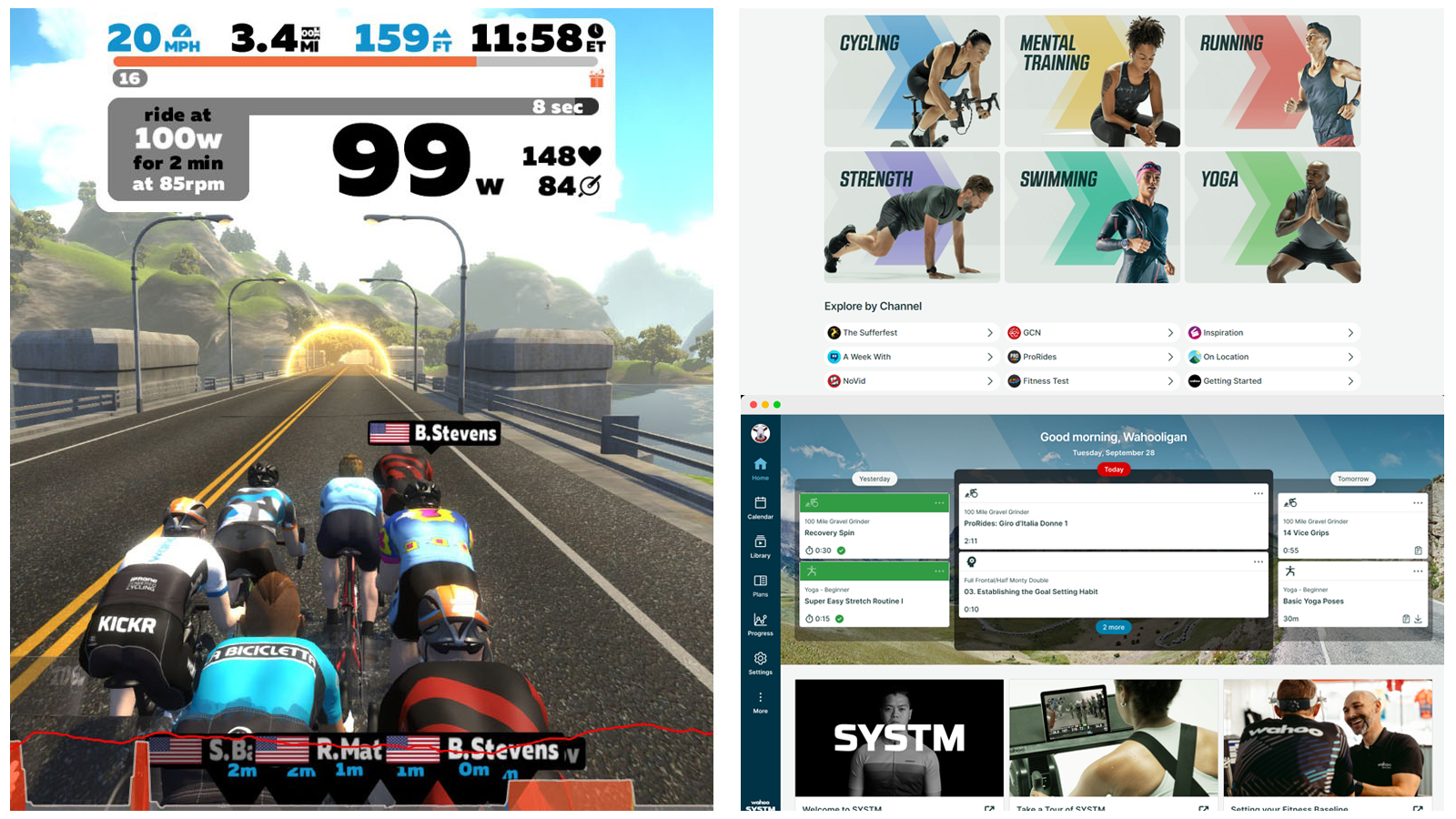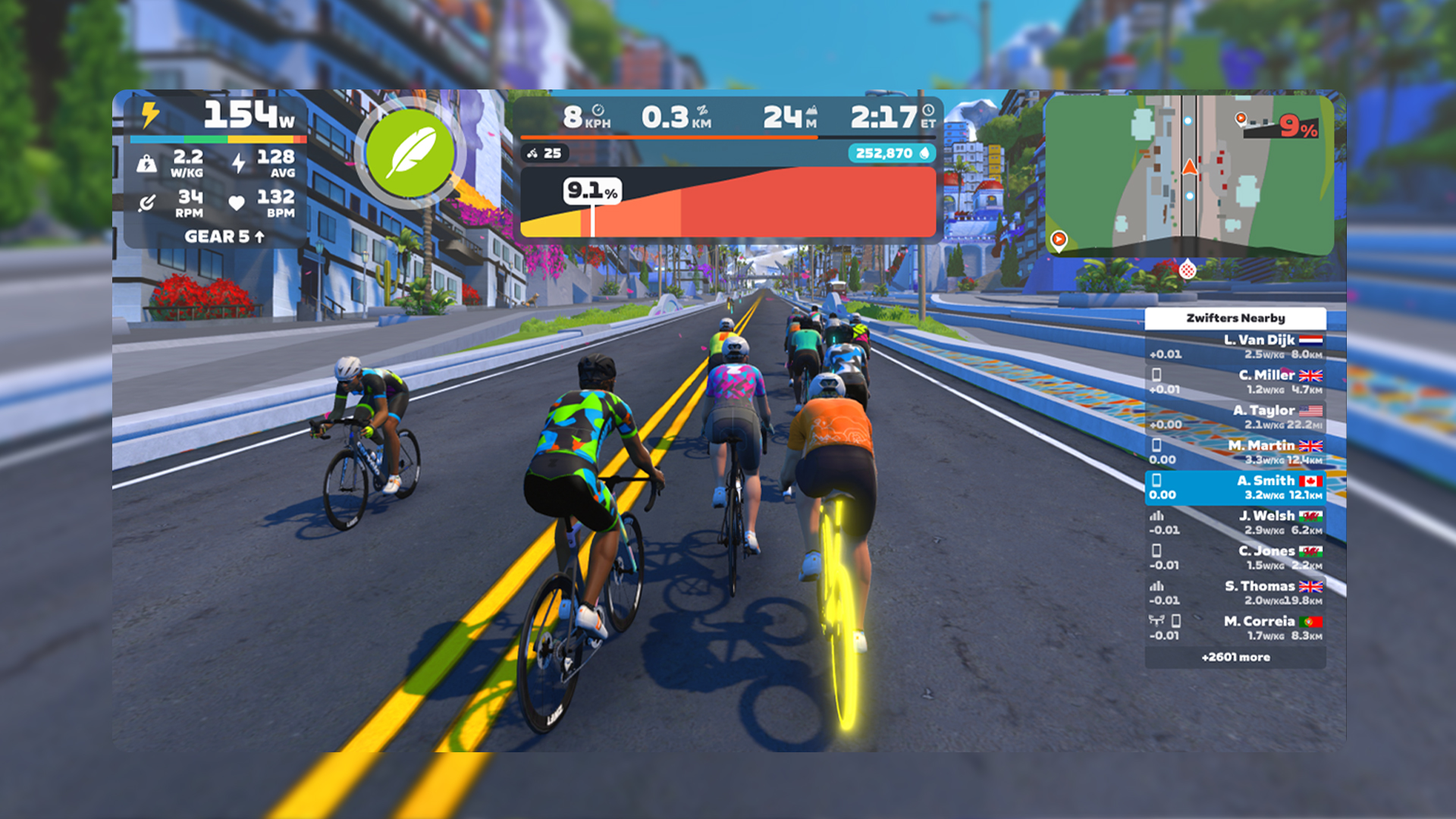
While Zwift is by far the most popular indoor cycling app in the world, there are a number of other apps, each with dedicated followings that promote the unique features that their platform offers. TrainerRoad and Rouvy come to mind, as well as Wahoo X, which is Wahoo's subscription to give you access to Wahoo Systm – formerly known as The Sufferfest – which is a comprehensive training app designed for performance-based endurance athletes looking to unlock their performance potential.
Both Zwift and Systm are compatible with any of the best smart trainers, so long as they're 'smart', as well as most of the best exercise bikes, and offer a wide variety of leg-burning workouts, accompanied by a high-tech display and helpful cues. But it is the community aspect where the platforms suddenly diverge.
In this article, we’ll take a look at the similarities and differences between Zwift and Systm, and how to decide which of the two indoor cycling apps might be best for you.
Zwift

The most popular indoor training platform in the world, which caters to serious cyclists, weekend warriors, the casual spinner, and everyone in between – Zwift continues to dominate the indoor training space, with over a million active users. The massiveness of Zwift’s community is what separates it from other virtual training platforms. Races and group rides for riders of all ages and abilities are held 24/7/365, plus, users can create their own meetups and group rides on any course at any time.
Zwift racing itself has ascended past weekday group rides and ‘Wednesday Night Worlds’ – the virtual Tour de France was never going to replace the real thing, but the UCI Esports World Championships is now an annual event and Zwift hosted the first few editions, MyWhoosh will host the championships this year. Now, the community-driven Zwift Racing League is a weekly feature in many cyclists' lives. The annual Zwift Academy competition has allowed some amateurs to develop successful pro careers including Neve Bradbury and Jay Vine.
There is so much ground to cover and so many races to talk about that it’s impossible to summarise it all in one article – so we’ll just say this: the Zwift community is unfathomably massive, and Zwift’s ability to connect millions of riders from around the world is what truly separates Zwift from its indoor training space competitors, no matter if you're using one of the cheapest Zwift setups or you have a dedicated pro pain cave.

Users also love Zwift for its personality and customisable features, such as changing the shoes, kit, hairstyle, and bike of your avatar. The colourful graphics and mix between real-life and imaginary worlds create a unique and ever-expanding landscape for thousands of users each day. Zwift users can also level up by gaining experience points (XP) by riding more kilometres, completing routes and KOMs, and earning in-game achievements such as power targets.
Like other virtual riding platforms, there is an enormous library of Zwift workouts and Zwift training plans in its user interface – just about every timestamp and intensity is covered, including sprints, tempo intervals, threshold sessions, and lung-bursting VO2 max efforts. Although you can ride for hours on Zwift, it also offers sub-hour rides. There is also the ability to perform group workouts in Zwift, as opposed to solo suffering.
To connect with the hundreds of thousands of other users, Zwifters can use the Zwift Companion app, a free app available on iOS and Android in which you can find and sign up for events, send and receive messages, as well as follow and give ‘ride-ons’ to other users.
Setting up to ride on Zwift is as simple as many other platforms – users can connect to Zwift with a smart trainer or an external power meter via ANT+ or Bluetooth. Smart trainers are not required for Zwift – instead, users can connect to Zwift using just a speed and cadence sensor.
Wahoo Systm

A Wahoo X subscription gives access to the Wahoo System and costs a little less than Zwift. It's currently $14.99 per month or $149 per year and there's a 14 day free trial offer. It offers an all-in-one training platform for cyclists and triathletes, complete with various different forms of video entertainment to keep your mind occupied while the legs do the spinning.
The Systm platform is geared towards helping its users get fitter and faster. Start by telling it what you wish to achieve - are you training for a triathlon, a time trial or a criterium? - and when your end date is, such as a race or the start of a season. From here it uses its four-dimensional power testing protocol, rather than the single metric of Functional Threshold Power (FTP). It then draws from the expertise of the coaches behind the scenes whose prescribed workouts will work you towards success.
However, beyond just turning pedals in the pursuit of fitness, Systm considers the body as a whole, integrating other activities such as strength and conditioning sessions, yoga, and mental toughness training.
Cleverly, the type of entertainment on offer with each session adjusts as the intensity does, so a long zone-two ride is often accompanied by an inspiring documentary, while harder rides are joined by hyper-motivational race footage videos, made famous during the app's years as Sufferfest.
Unlike Zwift and other apps based on virtual worlds, Systm videos immerse you in the real world. Some put you into a peloton, fighting for wheels at over 50kph or dancing up switchbacks in the Pyrenees; others allow you to ride with famous pros; and there are even instructor-led videos like you'll find in Peloton or a live spin class.
Zwift vs Wahoo X – Which do you choose?
Perhaps the biggest difference between Zwift and Wahoo Systm is the community aspect. Systm is all about training on your own, providing you with a structured training plan that is focused and uses highly-structured workouts with lots of audio and visual aids. If the quest is to get fit and reach your performance potential, if you want to get inspired by the real world, to watch the Tour of Flanders while also trying to churn out the watts of Mathieu van der Poel and Elisa Longo Borghini, Systm is the better of the two. The science-backed workouts and training system are among the best in the world – Systm's creators are coaches of WorldTour riders and national cycling teams, after all. No equivalent in Zwift can challenge the personalised training and interval quality offered by Systm.
Alternatively, Zwift has tens of thousands of riders pedalling around its virtual roads every day. Perhaps your motivation is low, or your legs aren’t feeling great on the day - having a group ride to join or simply having other riders suffering on the same climb with you, or a rider in the distance to chase, can do wonders for your mentality, especially when it comes to the isolating nature of virtual cycling.
Zwift is for users who want to ride with - or race against - others, and who don’t care as much if their workout is a bit chaotic. With hundreds of routes and races to choose from, the options on Zwift are almost endless. The workout library is there too, but with a more ‘gamey’ feel than platforms like Systm. It offers a greater variety of workouts, routes, races, and community engagement than Systm. For cyclists looking for a little bit of everything – from group rides to endurance workouts to weeknight races and weekend fondos – Zwift will be the better bet.







